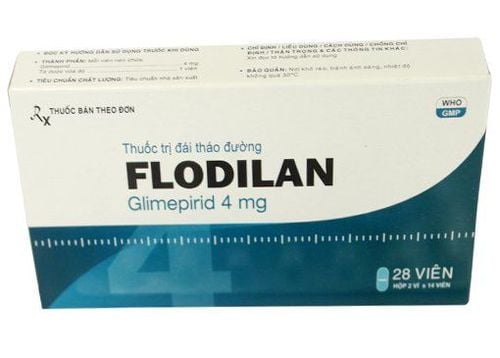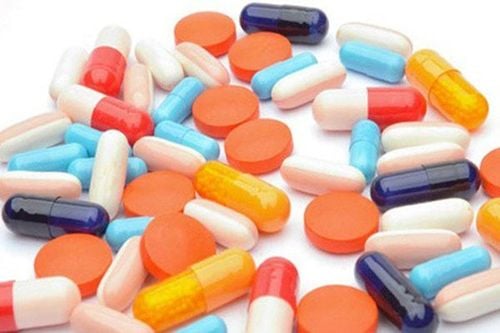This is an automatically translated article.
Glimauno drug has the main active ingredient Glimepiride with a concentration of 2mg and other excipients in a sufficient amount. Glimauno belongs to the group of hormonal drugs, which are effective in the treatment of type 2 diabetes.
1. What is Glimauno?
Glimauno drug has the main active ingredient Glimepiride with a concentration of 2mg and other excipients in a sufficient amount. Duaryl belongs to the group of hormonal drugs, which are used to treat type 2 diabetes.
Glimauno drug is made in the form of tablets, suitable for direct oral use. Packing is a box of 2 blisters and each blister contains 15 tablets.
1.1. Pharmacodynamics of the drug Glimepiride The drug is active orally (A: digestive system and metabolism).
1.2. Pharmacokinetics of the drug Glimepiride Absorption: The active substance Glimepiride has almost complete bioavailability. Food does not significantly change the absorption of this drug, but the rate of absorption may be slightly slowed. The maximum plasma concentration (Cmax) of the active substance is reached approximately 2 hours and 30 minutes after oral administration on average. Distribution: Glimepiride has a very low distribution potential. The elimination half-life, calculated from measured serum concentrations after repeated therapeutic doses, is between 5 and 8 hours. However, when the drug is used in high doses, a longer half-life has been reported. Metabolism: Two metabolites formed in the liver were detected in both urine and feces. It is a hydroxy derivative and a carboxy derivative of the active ingredient Glimepiride. Elimination: Following oral administration of Glimepiride, the terminal half-lives of the metabolites are 3 to 6 hours and 5 to 6 hours, respectively.
2. What are the effects of Glimauno?
Glimauno is used in combination treatment with daily nutrition and exercise regimen to control blood sugar for people with type 2 diabetes who are not insulin dependent.
3. Usage and dosage of the drug Glimauno
Usage and dosage of the drug Glimauno as follows:
3.1. General principles of treatment Patients should use the lowest therapeutic dose that controls the desired blood glucose level. The therapeutic dose must be initiated and monitored by the treating physician. Patients need to take Glimauno at the right dose and at the right time as prescribed by the doctor. The treating physician should instruct the patient in advance about what to do in the event of a specific violation of the regimen, such as forgetting to take a dose, forgetting a meal, or not being able to take it. medicine at the time prescribed in the prescription. Never make up a missed dose by taking a higher dose. If you find that you have used a therapeutic dose that is too high or taken an excess of a therapeutic dose, you need to notify your doctor for advice and timely treatment. Treatment with Glimauno is usually long-term. 3.2. Dosage of the drug Glimauno Therapeutic dose for adults: Initial dose for those who have not been previously treated for diabetes: 1-2 mg/day. People who are malnourished, debilitated or elderly, people with liver or kidney failure, people at risk of hypoglycemia: take 1mg/day; People who have been treated with other antidiabetic drugs: 1-2 mg/day, up to 2 mg/day. Maintenance dose: 1 - 4 mg/day (for those already on treatment with the active ingredient Glimepiride 1mg/day, increase to 2 mg/day if still not reaching the desired blood glucose level after time). from 1 to 2 weeks of treatment; after taking up to a dose of 2mg, subsequent dose adjustment depends on tolerability and response); should increase the therapeutic dose slowly, each time increasing the dose not more than 2 mg / day, at intervals of 1-2 weeks; up to 8 mg/day. It should be noted: The above drug dosage is for reference only, patients need to see a specialist for advice on how to use and dose the drug effectively. Because each patient will have a different condition and response to medication. Patients need to follow those instructions exactly to achieve the effect, and at the same time avoid unwanted side effects and drug interactions.
3.3. Usage of the drug Glimauno Glimauno drug is prepared in the form of tablets, suitable for direct oral use. Glimauno should be taken once a day with breakfast or the first main meal of the day.
3.4. Adjusting the therapeutic dose of Glimauno The doctor will adjust the therapeutic dose of Glimauno in the following cases:
Caused by improved insulin sensitivity when the disease is under control, the need for the active ingredient Glimepiride may decrease with treatment after some time. In order to avoid hypoglycaemia, it is necessary to reduce the therapeutic dose or stop using the drug in time. The weight of people using Glimauno can be changed. The lifestyle of users of Glimauno drug changes. Factors that can cause increased sensitivity to raised or lowered blood sugar.
4. Undesirable effects of the drug Glimauno
During the use of Glimauno, you may experience some specific undesirable effects as follows:
The most important undesirable effect is a decrease in blood sugar. Common undesirable effects include headache accompanied by dizziness, dizziness; nausea , vomiting a lot , feeling of bloating , abdominal distension , pain in the epigastrium , abdominal pain , diarrhea ; Temporary visual disturbances when starting to use Glimauno .
5. Glimauno drug interactions
Glimauno drug may cause interactions with drugs such as:
When using Glimauno together with insulin, oral diabetes drugs, chloramphenicol, coumarin derivatives, MAOIs, miconazole, phenylbutazone, -blocker increases the hypoglycemic effect. of the active ingredient Glimepiride. Simultaneous use of Glimauno with Acetazolamide, Barbiturates, Phenytoin, Glucagons reduces the effect of Glimepiride active ingredient. Drugs Glimauno used concurrently with antihistamines H2, clonidine, reserpine, alcohol: change the effect of the main active ingredient Glimepiride. The active ingredient Glimepiride changes the effect of the anticoagulant Coumarin. In order to avoid drug interactions, patients need to inform their doctors about drugs, herbs, functional foods, melasma drugs, traditional medicines, health care products so that the doctor knows and Consider prescribing, advise on the most effective time to use.
6. Some notes when using Glimauno
During the use of Glimauno, patients need to pay attention to the following issues:
6.1. Contraindication of Glimauno drug Glimauno is contraindicated in the following cases:
People with a physical condition or a condition that are sensitive or hypersensitive to the main active ingredient Glimepiride, Sulfonylurea or Sulfamid or any of its ingredients. medicine. People with insulin-dependent diabetes, coma and diabetic ketoacidosis. People with liver failure, severe kidney disease: Should switch to using insulin. Women who are pregnant and breastfeeding. Contraindication here means absolute contraindication. For no reason should this contraindication be flexible in the use of the drug.
6.2. Notes and precautions when using Glimauno Use caution when using Glimauno in the following cases:
Glimauno should not be used by pregnant women and nursing mothers and children. Be aware of the risk of hypoglycemia or loss of blood sugar control for the person using the drug. Loss of blood sugar control can occur in people who are stable on a diabetes treatment regimen but have persistent stressors such as fever, trauma, infection, or surgical intervention. Allergic reactions: There have been reports of allergic reactions occurring during treatment with the active ingredient Glimepiride, including Glimauno, including: hypersensitivity, angioedema, Stevens-Johnson syndrome. If an allergic reaction is suspected, you should promptly stop using the medicine containing the active ingredient Glimepiride. Hemolytic anemia: Hemolytic anemia has been reported in individuals with or without deficiency of the enzyme glucose 6-phosphate dehydrogenase (G6DP). Increased risk of cardiovascular events: An increased cardiovascular risk has been reported with the use of oral hypoglycemic agents compared with diet alone or a combination diet. with insulin. Low or high blood sugar, impaired vision can reduce the ability to concentrate and react. Therefore, you need to be careful when doing tasks that require high concentration such as driving or operating machinery. Glimepiride-containing medicines, specifically Glimauno, should not be used in people with rare hereditary problems of lactose intolerance, total lactase deficiency or glucose-galactose malabsorption. Above is all information about Glimauno drug, patients need to carefully read the instructions for use, consult a doctor / pharmacist before using. Absolutely do not arbitrarily buy Glimauno to treat the disease at home because it may cause unwanted side effects to health.
Follow Vinmec International General Hospital website to get more health, nutrition and beauty information to protect the health of yourself and your loved ones in your family.
Please dial HOTLINE for more information or register for an appointment HERE. Download MyVinmec app to make appointments faster and to manage your bookings easily.













